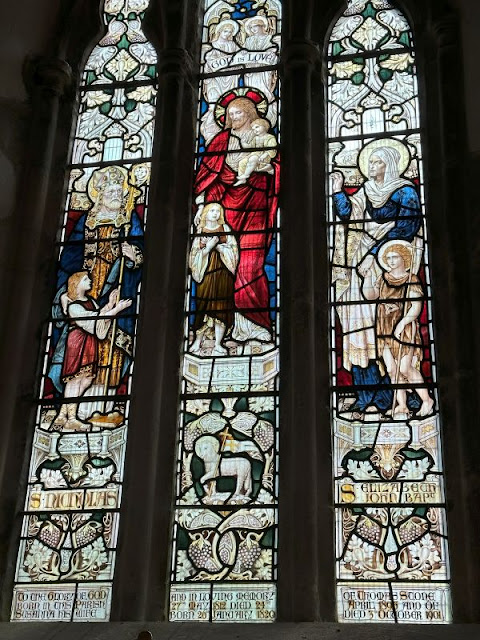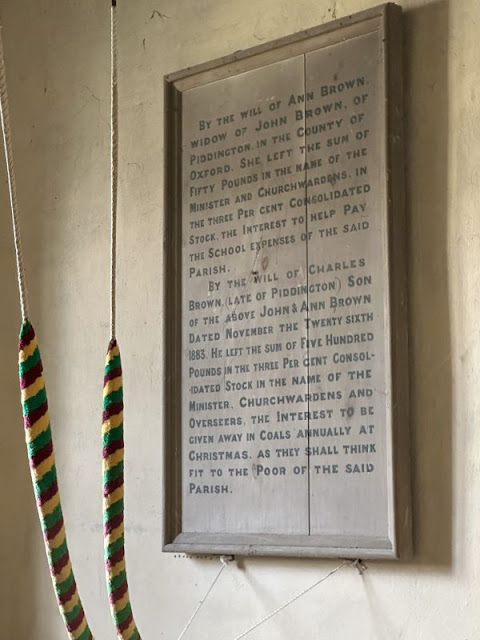St Nicholas Piddington is listed as one of Oxfordshires Best Churches and one in a list of churches I would like to visit that are listed in the book. There are over 100 to visit and a good few are in Oxford which I will be trying to visit as well. So far I realise I have been to over two thirds of the churches listed. Piddington was one of the furthest I have been to while I waited to pick my son up from the JR. You are almost in Bicester when you get there and it is easy to miss the turning to the village
St Nicholas church from over the churchyard. Below is the history of Wikipedia
"Piddington was originally part of the ecclesiastical parish of Ambrosden. By 1152 "Ralph the hermit" had established Holy Cross chapel on Muswell Hill about 1 mile (1.6 km) south of the village. Until the English Reformation,
Piddington villagers used to process to the chapel on Christian feast
days. The last ruins of the chapel are reported to have disappeared in
1800. The chapel of Saint Nicholas in Piddington is known to have existed by 1309. It is now Piddington's Church of England parish church. Its Early English chancel was built in about 1300, but has ornate Decorated Gothic sedilia and Easter Sepulchre carved in about 1350. There is a canonical sundial on the south wall. In the 14th century the Decorated Gothic south aisle was added, with a four-bay arcade and some new two-light windows, but also re-using two Early English lancet windows presumably from the south wall of the nave.
A number of Perpendicular Gothic windows were later added to the nave and one to the north wall of the chancel. The present belltower was built in the 16th century. St. Nicholas' parish church was repaired in 1826 and restored in 1855. In 1898 it was restored again under the architect John Oldrid Scott, whose alterations included replacing the chancel arch. A 14th-century wall painting of Saint Christopher on the north wall of the nave was discovered in 1896 and restored in 1935. St. Nicholas' church is a Grade II* listed building.
The west tower has a ring of five bells. Edward Hemins of Bicester cast the tenor bell 1729 in and the fourth bell in 1738. Llewellins and James of Bristol cast the treble, second and third bells in 1887, the year of Queen Victoria's Golden Jubilee. St Nicholas' parish is part of the Benefice of the Ray Valley, along with the parishes of Ambrosden, Charlton-on-Otmoor, Islip, Merton, Murcott, Noke, Oddington and Woodeaton."
Taken from the footpath, the bell tower is shorter that most churches I have visited
West end of the church with door, this was the nearest I could get as the boundary is where the hedge is
North side view of the church
East end with the triple east window
South east end where you can see a narrow priest door, the one thing I missed was the mass dial by the door
South west end showing the tower
Looking north west to the tower
West door in the Base of the tower
Path leading through the churchyard
As you get near the church you see the older headstones
A single chest tomb stands amongst the headstones
Collage of headstones and tombs
Older headstones
Graves at the east end of the church
View of the church as you walk in
Looking down the nave
Chancel arch
In the chancel
Altar with kneelers at the base
Looking back through the church from the chancel
Pulpit which looks quite modern
Nave and south aisle from the pulpit
South aisle with organ at the end
Altar panel and east window
The east window
The only other stained glass is this lancet window
The other window no less nice to look at are plain glass
At the back of the church a panel divides off the bells pulls
One walls above remnants of medieval wall paintings
The organ in the south aisle
Memorial to Leonard Busby who died in action 1917
If you can look over the divider in to were the bells are rung you will see another memorial
To Lieut R Stone of the RAF who died in 1918
Will bequests on a panel
You can find these interesting memorials on the north wall of the chancel
Three memorials in the chancel
some of the carvings on the memorials
This looks like it is an old stoup
Decorated Gothic sedilia
Carvings you can see in the church
This gem was hidden behind a chair on the north wall of the chancel, it's an Easter Sepulchre carved in about 1350.
The font which I cannot give an age to
I will leave you with this shot of the old altar panel
Till next time I wish you all a peaceful weekend


























































